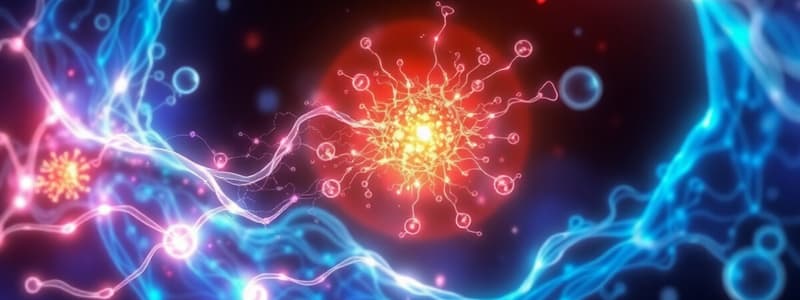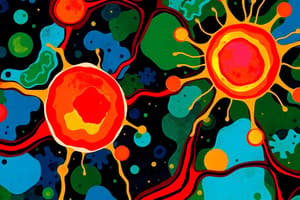Podcast
Questions and Answers
What is the primary function of signal transduction in cells?
What is the primary function of signal transduction in cells?
- Transportation of molecules across membranes
- Conversion of energy into motion
- Conversion of information from one form into another (correct)
- Storage of genetic information
Which describes a key aspect of how cells communicate within the human body?
Which describes a key aspect of how cells communicate within the human body?
- Cells use electrical signals exclusively for communication.
- Cells rely solely on direct contact for communication.
- Cells communicate primarily through chemical signals. (correct)
- Cells are completely isolated and do not communicate.
What is the primary role of phosphorylase in the described process?
What is the primary role of phosphorylase in the described process?
- It activates phosphorylase kinase. (correct)
- It breaks down glucose.
- It adds phosphate to other enzymes.
- It deactivates phosphorylase kinase.
How does phosphorylase kinase get activated in this context?
How does phosphorylase kinase get activated in this context?
In cellular communication, what is the importance of signal transduction pathways?
In cellular communication, what is the importance of signal transduction pathways?
What is a consequence of phosphorylase kinase being activated?
What is a consequence of phosphorylase kinase being activated?
Which of the following is a misconception about signal transduction?
Which of the following is a misconception about signal transduction?
What element is crucial for the effective functioning of signal transduction mechanisms?
What element is crucial for the effective functioning of signal transduction mechanisms?
Which process is indirectly facilitated by the action of phosphorylase?
Which process is indirectly facilitated by the action of phosphorylase?
What type of reaction does the activation of phosphorylase kinase involve?
What type of reaction does the activation of phosphorylase kinase involve?
What is the primary mechanism of action in paracrine signaling?
What is the primary mechanism of action in paracrine signaling?
Which of the following best describes the role of endocrine cells in paracrine signaling?
Which of the following best describes the role of endocrine cells in paracrine signaling?
How do hormones typically reach their target cells in endocrine signaling?
How do hormones typically reach their target cells in endocrine signaling?
What happens to a radio signal when it enters a mobile phone?
What happens to a radio signal when it enters a mobile phone?
What distinguishes paracrine signaling from endocrine signaling?
What distinguishes paracrine signaling from endocrine signaling?
What is a characteristic feature of paracrine hormone action?
What is a characteristic feature of paracrine hormone action?
Which process is comparable to the signal conversion in a mobile phone?
Which process is comparable to the signal conversion in a mobile phone?
Why is the conversion of radio signals in mobile phones important?
Why is the conversion of radio signals in mobile phones important?
In what way does the conversion of radio signals in mobile phones reflect biological processes?
In what way does the conversion of radio signals in mobile phones reflect biological processes?
Which aspect of signal transduction is illustrated by the conversion of radio signals in a mobile phone?
Which aspect of signal transduction is illustrated by the conversion of radio signals in a mobile phone?
What is the primary cause of the disease mentioned?
What is the primary cause of the disease mentioned?
Which substance is produced by the bacterium in the intestine?
Which substance is produced by the bacterium in the intestine?
Where does the bacterium that causes the disease primarily multiply?
Where does the bacterium that causes the disease primarily multiply?
What is one significant consequence of the cholera toxin produced by the bacterium?
What is one significant consequence of the cholera toxin produced by the bacterium?
Which of the following statements is accurate regarding the bacterium's function?
Which of the following statements is accurate regarding the bacterium's function?
What is the role of cyclic AMP in the activation of PKA?
What is the role of cyclic AMP in the activation of PKA?
What happens to PKA when it is activated by cyclic AMP?
What happens to PKA when it is activated by cyclic AMP?
Why is PKA initially inactive before activation by cyclic AMP?
Why is PKA initially inactive before activation by cyclic AMP?
In the context of PKA activation, what does phosphorylation refer to?
In the context of PKA activation, what does phosphorylation refer to?
What is the initial state of PKA before it interacts with cyclic AMP?
What is the initial state of PKA before it interacts with cyclic AMP?
Flashcards
Radio signal conversion
Radio signal conversion
The process of converting a radio signal into sound waves within a mobile phone.
Signal transduction
Signal transduction
The process by which cells receive and respond to external signals.
Signal transduction analogy
Signal transduction analogy
The analogy used to explain how radio signals are transformed into sound waves in a mobile phone.
Radio Signal
Radio Signal
Signup and view all the flashcards
Sound waves
Sound waves
Signup and view all the flashcards
Cell-to-cell Communication
Cell-to-cell Communication
Signup and view all the flashcards
Ligand
Ligand
Signup and view all the flashcards
Receptor
Receptor
Signup and view all the flashcards
Signal Transduction Pathway
Signal Transduction Pathway
Signup and view all the flashcards
Paracrine signaling
Paracrine signaling
Signup and view all the flashcards
Endocrine cells
Endocrine cells
Signup and view all the flashcards
Hormones
Hormones
Signup and view all the flashcards
Local mediator
Local mediator
Signup and view all the flashcards
Cholera bacterium
Cholera bacterium
Signup and view all the flashcards
Cholera toxin
Cholera toxin
Signup and view all the flashcards
Cholera bacterial multiplication
Cholera bacterial multiplication
Signup and view all the flashcards
Human intestine
Human intestine
Signup and view all the flashcards
Cholera
Cholera
Signup and view all the flashcards
Cyclic AMP
Cyclic AMP
Signup and view all the flashcards
PKA
PKA
Signup and view all the flashcards
Phosphorylation
Phosphorylation
Signup and view all the flashcards
Inactive state
Inactive state
Signup and view all the flashcards
Phosphatase
Phosphatase
Signup and view all the flashcards
Kinase
Kinase
Signup and view all the flashcards
Phosphorylase kinase
Phosphorylase kinase
Signup and view all the flashcards
Phosphorylase
Phosphorylase
Signup and view all the flashcards
Study Notes
Signal Transduction Lecture Notes
- Signal transduction is the conversion of information from one form into another
- It begins when a target cell receives an incoming extracellular (EC) signal and converts it into intracellular (IC) signals that alter cell behavior
- Cell-cell communication is crucial for coordinating the behavior of unicellular and multicellular organisms. This includes growth, development, differentiation, tissue and organ formation, maintenance, homeostasis, and disease processes.
- An example of cell signaling is the fight-or-flight response which is triggered by a signaling molecule called epinephrine.
- The process of signal transduction involves three stages:
- Reception: The signaling molecule (ligand) binds to a specific receptor protein on the target cell. This binding initiates a series of events within the cell.
- Transduction: The binding of the signaling molecule to the receptor protein triggers a cascade of intracellular signaling molecules. A relay team of communication proteins in the cell are activated.
- Response: The final signal triggers a specific cellular response, such as activating a gene, triggering apoptosis, entering mitosis, or inducing secretion.
- Signal transduction involves the conversion of extracellular signals to intracellular signals.
- Cell communication is similar to human communication but cells have their own special messages.
- There are three types of cell-surface receptors : ion-channel-coupled, G-protein-coupled (GPCRs), and enzyme-coupled receptors .
- GPCRs activate G-proteins, which then transmit signals and turn off.
Signal molecule classification
- Hydrophilic/large signal molecules rely on cell-surface receptors. Examples include growth factors and some proteins that relay signals in the central nervous system.
- Hydrophobic/small signal molecules activate intracellular receptors. Steroid hormones are an example of this type of signal.
Important signal molecules
- Hormones: Examples include epinephrine (adrenaline), cortisol, estradiol, insulin, testosterone, and thyroid hormone. Various tissues produce hormones, and hormones transmit messages throughout the body. Specific hormones affect particular cells. The effects of hormones can vary based on the target cells in their specific responses.
- Local Mediators: Other signal molecules, such as Epidermal growth factor (EGF), Platelet-derived growth factor (PDGF), Nerve growth factor (NGF), Histamine, Nitric oxide, Acetylcholine and γ-Aminobutyric acid (GABA), regulate cellular interactions in the body locally. They target nearby cells.
Signal transduction and disease
- Defective signaling pathways lead to diseases.
- Drugs, poisons, and pesticides often target signaling pathways to modify cellular activity.
- For example, cholera toxin affects G-proteins, blocking their ability to hydrolyze GTP. This results in prolonged activation of the G protein, abnormal chloride and water outflow into the gut, causing diarrhea, and dehydration.
Quiz Questions
- Which signaling molecule is an example of a hormone that acts in endocrine signaling?
- Insulin
- Cholera toxin interferes with which part of the G-protein process?
- Prevents Gs from hydrolyzing GTP
Lecture Outline of Signal Transduction
- Definitions
- General principles of cell signaling and Signal Transduction
- Types of intercellular signaling
- Chemical nature of some signal molecules
- Different responses of cells to the same signal molecule
- Molecular on/off switching in signal transduction
- Signal transduction through the various types of receptors
Studying That Suits You
Use AI to generate personalized quizzes and flashcards to suit your learning preferences.




